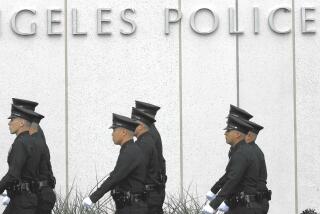More Cops Die in Car Crashes Than by Guns
- Share via
WASHINGTON — Officer David Scott was in hot pursuit of a robbery suspect when he swerved to avoid a car in his way. His police cruiser crossed into oncoming traffic and was slammed by a pickup truck.
Scott and his rookie partner in the Clarksville, Tenn., police department, Yamil Baez-Santiago, were killed. The truck driver suffered minor injuries.
The incident is part of a worrisome trend in law enforcement: More officers are being killed in traffic accidents. Twice in recent years -- 1999 and 2003 -- car crashes topped guns as the No. 1 killer of on-duty officers.
Although year-to-year variations are common, the National Law Enforcement Officers Memorial Fund, which tracks fatalities, says the trend becomes apparent when the numbers are spread over many years. In the decade ending last year, 477 officers died in auto accidents. That was up 29% from the 369 of the previous decade and 39% from the 342 killed the decade before that.
There’s no single reason for the increase. Part of the answer is there are more police cars on the roads -- 52 per 100 county and city officers in 2003, compared to 49 in 1997, according to the Bureau of Justice Statistics. There also are more deaths from high-speed chases.
Advocacy groups say there are other reasons too.
Suzie Sawyer, executive director of Concerns of Police Survivors Inc., thinks more criminals are using their vehicles to run down officers, though she has only anecdotal evidence. Her group provides emotional support for relatives of police officers killed in the line of duty.
Memorial Fund spokesman Bruce Mendelsohn points to more drivers using cellphones and other devices that can distract them from the road and make them oblivious to police cars. But he also said officers and their departments may share some of the blame.
Nearly all law enforcement officers receive driver training. But the standards vary and refresher courses are rarely mandated. Mendelsohn says that leaves some officers ill-prepared for the dangerous driving situations they face. His organization is pushing for more training.
He also said officers could help themselves by buckling up and wearing body armor. Many didn’t, complaining the safety devices were cumbersome and restrictive.
“There’s absolutely no doubt in our minds that officers who wear their [body armor] are more protected, both from shootings and from injuries they can sustain from auto accidents,” Mendelsohn said. “Step two is providing better training -- high-speed driver training, certainly, is expensive, but that cost is nothing compared to the death of an officer.”
Mendelsohn also suggests police departments outfit vehicles with the kind of seat belts race car drivers use. They latch in front of the driver’s chest, not at the lower right hip, allowing more freedom of movement.
Mike Robb of the Homeland Security Department’s Federal Law Enforcement Training Center in Glynco, Ga., helps run a driver training program for federal officers.
Robb’s program puts officers in the vehicles they’ll be using on the job so they can learn to be comfortable driving powerful machines that may differ significantly from their civilian cars. He also tries to prepare officers to make split-second decisions about how to pursue a criminal without endangering the public.
“There’s a stress that goes with these responses,” he said.
Ronald McBride, a retired Ashland, Ky., police chief who consults for the DuPont Survivors Club, which pushes for officer safety, said greater use of body armor would reduce traffic deaths. He cited one case in which an officer survived despite being thrown from his vehicle, then run over by it. The officer’s doctor believes the armor saved his life.
“They’re uncomfortable physically and they’re uncomfortable psychologically,” McBride said of the armor. “But the cold hard truth is body armor saves lives.”
More to Read
Sign up for Essential California
The most important California stories and recommendations in your inbox every morning.
You may occasionally receive promotional content from the Los Angeles Times.














